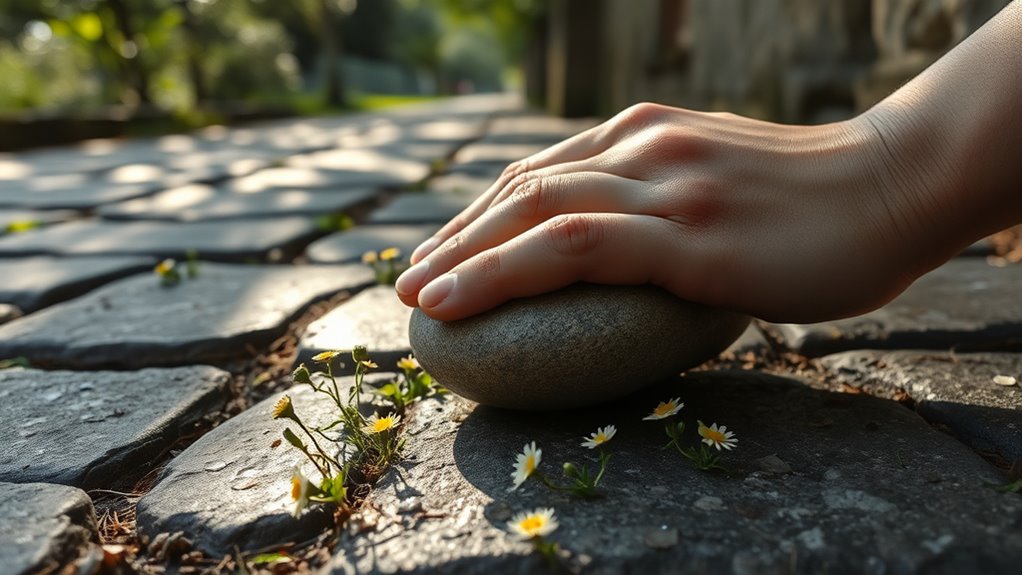Emotional first aid equips you with essential tools to tackle life’s mini crises. When overwhelmed, pause for a deep breath to calm your nerves and become present. Show yourself compassion, acknowledging that struggling is okay. Journaling can help unpack emotions and identify triggers, while physical activities like walking or yoga can lift your mood. Don’t hesitate to connect with loved ones for support. These strategies foster resilience and empower you to handle emotional challenges. Discover more helpful techniques ahead.
Key Takeaways
- Practice grounding techniques, like deep breathing, to calm your nervous system during emotional overwhelm.
- Utilize journaling to unpack emotions and identify triggers that lead to mini crises.
- Engage in physical activity to release stress and boost mood through endorphin production.
- Implement self-compassion by treating yourself kindly and acknowledging struggles as part of the human experience.
- Reach out to friends or loved ones for support, fostering connection and emotional regulation during tough times.

Have you ever felt overwhelmed by your emotions and unsure how to cope? It’s a common experience, especially when you encounter a trauma response. These moments can leave you feeling like you’re drowning in a sea of anxiety, sadness, or anger. Learning to recognize these responses is the first step toward building emotional resilience. You have the power to tackle these feelings head-on, and with some practical tools, you can navigate life’s mini crises more effectively.
Feeling overwhelmed by your emotions is common, especially during trauma responses. Recognizing these feelings is the first step toward resilience.
One of the first things you can do is to pause and take a deep breath. It sounds simple, but grounding yourself in the present moment can help you regain clarity. Notice what’s happening around you and within you. Acknowledge your feelings without judgment. Recognizing that your emotions are valid is vital for developing emotional resilience. You’re not alone in this; everyone experiences difficult emotions at some point.
Another technique is to practice self-compassion. Instead of criticizing yourself for feeling this way, remind yourself that it’s okay to struggle. You’re human, and you’re allowed to have ups and downs. This shift in mindset can provide a sense of relief and help you move forward. When you treat yourself with kindness, you’re less likely to spiral into negative thoughts.
Journaling can also be a powerful tool. Write down what you’re feeling and why you think you’re feeling that way. This process can help you unpack your emotions and identify any triggers. Understanding what sparks your trauma response is essential in learning how to cope better in the future. You might even discover patterns that you can address more proactively.
Physical activity is another effective way to cope. Whether it’s going for a walk, dancing, or practicing yoga, movement can help release pent-up energy and stress. Engaging in physical activities releases endorphins, which can improve your mood and promote emotional resilience. Additionally, incorporating self-care practices like using eye patches can enhance your overall well-being and help you feel refreshed.
Lastly, don’t hesitate to reach out for support. Connecting with friends or loved ones who understand what you’re going through can be incredibly comforting. Sometimes, just talking about your feelings can lighten the load. Remember, seeking help is a sign of strength, not weakness.
In moments of emotional overwhelm, remember that you have tools at your disposal. By practicing mindfulness, self-compassion, journaling, moving your body, and connecting with others, you can navigate your feelings and reinforce your emotional resilience. You’ve got this!
Frequently Asked Questions
What Is the Difference Between Emotional First Aid and Therapy?
Emotional first aid and therapy serve different purposes. Emotional first aid focuses on immediate coping strategies to build your emotional resilience during a crisis, helping you manage feelings in the moment. Therapy, on the other hand, provides a deeper exploration of your thoughts and behaviors over time. While emotional first aid offers quick relief, therapy aims for long-term healing and understanding, addressing underlying issues that may cause emotional distress.
Can Emotional First Aid Be Practiced Alone?
Yes, you can practice emotional first aid alone. Using self-help strategies like mindfulness, journaling, or deep breathing can effectively address your emotional needs in tough moments. However, don’t underestimate the power of peer support. Sometimes, sharing your feelings with friends or joining a support group can enhance your healing process. Balancing self-care with social connections can empower you to navigate life’s mini crises more effectively and build resilience.
How Long Should I Practice Emotional First Aid Techniques?
You should practice emotional first aid techniques daily for at least 10 to 15 minutes. Studies show that consistent practice can improve emotional resilience by up to 25%. To maximize benefits, follow duration guidelines that encourage short, regular sessions instead of infrequent long ones. This approach helps you build skills over time, making it easier to cope with life’s mini crises. Remember, consistency is key to lasting emotional health!
Are There Any Risks Associated With Emotional First Aid?
Yes, there are risks associated with emotional first aid. You might develop emotional dependency on these techniques, relying too heavily on them instead of seeking professional help when needed. Additionally, there’s a chance of misdiagnosis—applying the wrong tools for your situation could lead to worsening feelings, rather than relief. It’s vital to balance self-help with professional guidance, ensuring you address underlying issues effectively. Remember, it’s okay to ask for help when needed.
How Do I Know if I Need Professional Help?
“When the going gets tough, the tough seek help.” You know it’s time to seek professional help if self-assessment indicators show persistent sadness, anxiety, or irritability that disrupts your daily life. If you’re struggling to cope with stress or find yourself withdrawing from loved ones, don’t hesitate. Recognizing when to seek help is vital for your well-being. Trust your instincts; reaching out can be a powerful step towards healing.
Conclusion
In moments of emotional distress, remember that just like treating a physical wound, you can apply emotional first aid. Imagine this: after a tough breakup, you take a walk, journal your feelings, and reach out to a friend. Each step helps you process and heal. By using practical tools, you can navigate life’s mini crises with resilience. So, the next time you’re feeling overwhelmed, don’t hesitate to pull out your emotional toolkit and take action.









